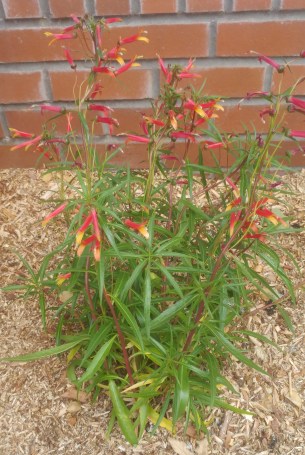We’ve discussed barerooting/rootwashing trees before, and research on this controversial topic continues. But what about smaller shrubs and woody perennials? What about herbaceous perennials? Basically, what about PERENNIALS???

I’ve always made a practice of rootwashing everything except for annuals. They don’t last long enough to suffer the perils of potbound plants. But many gardeners are nervous about disrupting more fragile root systems. Let’s see what happens when we do.

A little context: we’ve just moved to our family farm, which has AMAZING spring flowers that the bees love. But once those are gone…there’s nothing. I was desperate to provide some food for bees and butterflies, so it was off to the nursery to shell out a few hundred bucks for the beginnings of our south-facing pollinator garden – a previously barren spot left after construction of our porch.

So I bought Lavandula stoechas ‘Bandera Purple’ and ‘Winter Bee’, Salvia ‘Caradonna’, Agastache ‘Acapulco Deluxe Red’ and ‘Blue Boa’, Erysimum ‘Winter Passion’, Verbena ‘Homestead Purple’, and Lobelia laxiflora. I depotted and soaked them in a water bath, using a gentle hose setting to loosen up media in the center. For most of these plants, a massive root disk at the bottom of the pot had to be cut off like a giant slice of salami. If necessary, I “tickled” the remaining rootball to work out the rest of the media.
Here is Erysimum ‘Winter Passion’ potted, depotted, and washed.

The Agastache and Verbena cultivars were also in pretty good shape, much like the Erysimum. Just a gentle washing and tickling was enough to remove all the media and reveal the roots.
Here is Salvia ‘Caradonna’ potted, depotted, and washed, and Lobelia laxiflora potted, depotted, and washed.

 Apart from the root Frisbee on the bottom of each pot, the roots were confined to the center of the pot, pretty much where they had been in their previous container. So question number one for all of you gardeners – why would you want to dig a hole to plant all of that media (which is nothing like your soil)? My answer – you don’t! Keep that good organic material as part of your topdressing.
Apart from the root Frisbee on the bottom of each pot, the roots were confined to the center of the pot, pretty much where they had been in their previous container. So question number one for all of you gardeners – why would you want to dig a hole to plant all of that media (which is nothing like your soil)? My answer – you don’t! Keep that good organic material as part of your topdressing.
Here is Lavandula stoechas ‘Bandera Purple’ potted, depotted, and washed;
 and here is Lavandula stoechas ‘Winter Bee’ potted, depotted, and washed.
and here is Lavandula stoechas ‘Winter Bee’ potted, depotted, and washed.
 I have to take time out for a special rant about the lavenders (retailing at $19.99 and $12.99). Look at the root mass of the ‘Winter Bee’. It’s entirely unacceptable. The woody roots are in the shape of the liner pot from transplants past. News alert: these systems do NOT self-correct. They must be straightened or pruned to regain a natural structure. The ‘Bandera Purple’ – the more expensive of the two – was actually three plants in one color-coordinated bowl (“Go ‘Colour Crazy’ with matching pots and flowers”!). Fine by me – I just got 2 free plants. (By the way, this is nothing new for me – I’ve written about it previously here and here.)
I have to take time out for a special rant about the lavenders (retailing at $19.99 and $12.99). Look at the root mass of the ‘Winter Bee’. It’s entirely unacceptable. The woody roots are in the shape of the liner pot from transplants past. News alert: these systems do NOT self-correct. They must be straightened or pruned to regain a natural structure. The ‘Bandera Purple’ – the more expensive of the two – was actually three plants in one color-coordinated bowl (“Go ‘Colour Crazy’ with matching pots and flowers”!). Fine by me – I just got 2 free plants. (By the way, this is nothing new for me – I’ve written about it previously here and here.)
Another upside is that hole digging was short and sweet. Holes were just deep enough to accommodate the root mass and wide enough to allow roots to be spread. Soil was added and watered in. The leftover organic media was used as the first layer of topdressing, followed by a fresh woodchip mulch. And then irrigation to soak the mulch well.

It’s important when you rootwash plants to provide optimal soil water every day, particularly when it’s hot and sunny (as this south-facing garden is). Even with the gentlest root washing there will be a loss of fine roots. But the continuity of the soil system means that the soil around the roots will be just as moist as the rest of the bed. Roots left in soilless media quickly dry out. Yes, I had afternoon wilt on many of the taller plants during the first week or so, but they recovered every evening. The wilt has become less noticeable since then.

So here’s how they look 3 weeks after planting (sunny day, about 80°F). And I’m happy to report that not only birds and butterflies but hummingbirds have been visiting our pollinator oasis garden. And all those single photos scattered through the post? They are all close-ups from this garden – taken just minutes ago.

(Question number two for gardeners – what are you waiting for?)













































